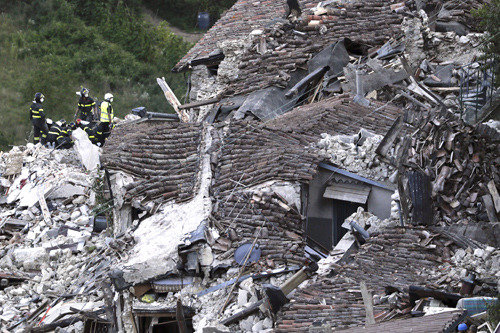A 6.2-magnitude quake hit central Italy
A 6.2-magnitude quake hit central Italy
Posted August. 26, 2016 07:15,
Updated August. 26, 2016 07:22

Digging through the rubble and wreckage with detection dogs, bulldozers, shovels and bare hands, local firefighters, soldiers, rescue workers and volunteers are struggling to pluck more survivors from the ruins. A 10-year-old girl was dramatically rescued from the collapsed buildings by firefighters in 17 hours after the quake in Pescara del Tronto. "Today is a day for tears. Tomorrow we can talk of reconstruction," Italian Prime Minister Matteo Renzi offered consolation at the scene.
Most of the affected areas such as Accumoli, Amatrice, Pescara del Tronto are located along the spine of the Apennine Mountains. With small population and merely vacation villas, those cities had been passive in investing in earthquake-resistant design, which has aggravated the damage, the CNN pinpointed. Having focused on reconstructing damages from the World Wars, Italy has provided few preparedness measures against earthquake with a lot of undocumented buildings.
“Italy’s beauty is fragile. Ancient buildings are gorgeous but can be dangerous. Its cities are old and dense, and its buildings rendered vulnerable by heritage laws that protect them from modernization, for better and worse,” said Beppe Severgnini in his column “Italy’s Fragile Beauty” in the New York Times. Buildings from the Middle Ages should be demolished and reconstructed to resist the earthquake.
Norcia, one of the affected cities, is the birthplace of Saint Benedict and a 12-century monastery thought to be his birth house was damaged. Museums in medieval fortress, 14-century frescos and city walls from the Roman Era are in danger as well. The ruin in Amatrice is reminding of a battleground. As the half of façade of 15th century Saint Augustine's Catholic Church was collapsed, the famously-beautiful rose window was gone. A garden in a large mansion built in the Renaissance Era has turned into a morgue.
There are concerns that the restoration work will be delayed for a long time. As the affected cities are in mountainous areas, “medieval-type” restoration should be made with bare hands and shovels. Bureaucracy of the Italian government and lack of financial resources darken the prospect of restoration work as well. In April 2009 when a 6.3-magnitude quake hit L'Aquila in the Abruzzo region, churches and schools began to be restored three years after the disaster due to lazy response from the government. Some 13.5 billion U.S. dollars has been spent for the work for the past seven years, and the restoration is expected to be completed in 2019.
On Wednesday when the earthquake hit the nation, Pope Francis along with some 10,000 audience in St. Peter’s Square at the Vatican prayed for the victims. Expressing his regret to Italian President Sergio Mattarella over the phone, U.S. President Barack Obama promised to provide much-needed aid for the affected nation. “The pictures we are seeing are awful. Our thoughts are with the people of the region today,” German Chancellor Angela Merkel told the Italian prime minister. “We are offering Italy all the help that might be necessary,” French President François Hollande said.
이유종기자 pen@donga.com







